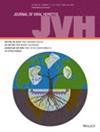Clinical Features and Transition of Acute Hepatitis B Virus Infection
Abstract
Acute hepatitis B (AHB) is generally a self-limiting illness in adults and most patients achieve hepatitis B surface antigen (HBsAg) clearance within 6 months. We aimed to investigate the proportion and influencing factors of chronic outcome in adult AHB patients. A total of 126 consecutive AHB patients were included between January 2013 and October 2018. Multivariate regression analysis was conducted to evaluate the influencing factor of HBsAg clearance. Fourteen (11.1%) patients failed to achieve HBsAg clearance within 6 months. Among them, nine patients achieved HBsAg clearance within 6–12 months, while five patients had persistent HBsAg positive over 1 year. Patients with HBsAg clearance had lower baseline antibody to hepatitis B core antigen (anti-HBc) (7.0 S/CO vs. 8.0 S/CO, p = 0.090) and HBsAg levels than those with chronicity of AHB. Multivariate analysis revealed that HBsAg ≤ 250 IU/mL (HR 3.008, IQR 1.877, 4.820, p < 0.001) and anti-HBc levels (HR 0.830, IQR 0.755, 0.912, p < 0.001) was significantly associated with HBsAg clearance. Anti-HBc remained an independent predictor of HBsAg clearance in different HBsAg subgroups. Patients with HBsAg > 250 IU/mL (p < 0.001) and high anti-HBc (p = 0.001) had lower cumulative HBsAg clearance rates than those with low HBsAg and anti-HBc. 11.1% of AHB patients did not achieve HBsAg clearance within 6 months, while the proportion of patients with persistent HBsAg positive decreased to 4.0% after 1 year. Combination of baseline HBsAg and anti-HBc levels could identify patients who might have a possible risk of chronicity following AHB.

 求助内容:
求助内容: 应助结果提醒方式:
应助结果提醒方式:


